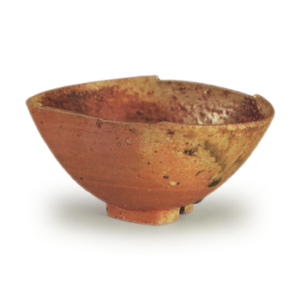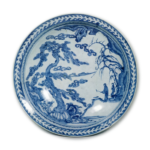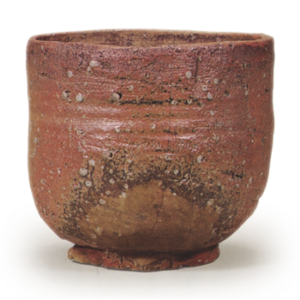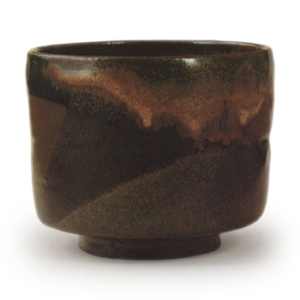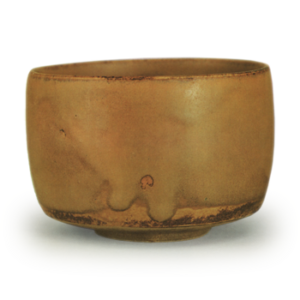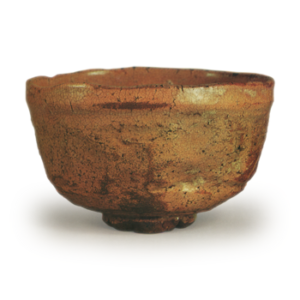Looking at the seventeenth century as a period in the history of ceramics in Japan, it can be said to have been a very important period. Historically speaking, the Edo period saw the consolidation of the shogunate and domain system, and it is often thought that the age of willful artifice seen in the Momoyama period had already passed away. Although qualitatively different from the Momoyama period, the ambitious development of ceramics in Hizen surpassed that of the Momoyama period, and Hizen showed a greater industrial character than the Momoyama period, establishing a system of mass production. Moreover, the fact that this was done not by the Tokugawa family or their parent clan, but by the Nabeshima and Kaga clans, even though they had a tradition of pottery-making techniques that had existed since the Momoyama period, may suggest that the Momoyama spirit was still strongly alive in those areas during the Genna, Kan’ei, and Kanbun periods. In particular, the fact that Arita, which was under the domain of the Nabeshima clan, began to export ceramics in the latter half of the 17th century is a phenomenon that deserves special mention in the history of Japanese economy.
During the Edo period, the term “Imariyaki” was a common name for all porcelain produced in Arita, and probably included Nabeshima ware, which was the official kiln of the domain. Nabeshima-yaki aside, the fact that what is generally referred to as Kakiemon-yaki today was also treated as Imari-yaki has already been mentioned in the text of Kakiemon. Needless to say, this name arose from the fact that the porcelain in dyed and colored colors produced in the Arita area was shipped by sea from Imari Tsu to various parts of the country.
It was not until the Taisho period (1912-1926) that the porcelain produced in the Arita area during the Edo period was color-coded into Imari, Kakiemon, and Nabeshima porcelains, and evaluated in the modern appreciation arena. In the 1950s, however, the popularity of imari ceramics began to increase, and the number of imari ceramics was increasing. In the 1950s, however, some potters began to pay attention to early Imari ceramics produced at an earlier date than the katamono, and their painted fluency and nanga style came into the limelight, and “early Imari” became the most attractive ceramic art of the Edo period. This was the beginning of a trend toward the appreciation of “early Imari” as one of the most appealing ceramics of the Edo period.
Arita was the Mecca of underglaze blue and white porcelain in Japan, and as such, it attracted attention from an academic standpoint as well, and excavation surveys of the old kiln sites were conducted under the leadership of researchers such as Kazusaburo Mizumachi and Takeshi Nagatake, and an excavation team led by Professor Tsugio Mikami was organized. The excavation team led by Professor Tsugio Mikami excavated the site of the famous Kamishirakawa Tengu Valley old kiln, which is a historical site of the birth of porcelain, from 1965 to 1965, and found that the date of the founding of porcelain ware in Arita is older than the conventional theory (Genna 2 – 1616, started by Lee Sanpei). In addition, the excavation and investigation of the Kake-no-Tani kiln site in Arita Outer Mountains in 1968, the Sarukawadani kiln site in Arita Inner Mountains in 1969, the Kuromuta-type Yamabeden old kiln site in Arita Outer Mountains for three times since the autumn of 1972, and the Tenjinmori old kiln site in 1974, etc., were also carried out. The shards collected from the Hyakuma kiln of the Takeo group, the Hiekoba kiln of the Uchiyama group, the Yamakoya kiln, and the Maruo kiln of the Outer Mountains of Arita, etc., which occupy a large position in early Imari ware, have made the style and distribution of so-called early Imari and Ko-Imari ware from the early to middle periods almost unmistakable. In the future, academic investigations of many kilns will be conducted to determine the stylistic chronology of styles, and a comprehensive study will be conducted by adding inherited pieces. Furthermore, the relationship between Ko-Kutani and Ko-Imari will also be clarified.
In compiling this volume, as in the other volumes, we have focused on the pieces that have been handed down from generation to generation, with the aim of making them useful materials for future research and appreciation of Imari ware. The contents of the book are composed of a large number of early Imari works, mainly in underglaze blue and white, which have been highly appreciated in recent years, and a large number of color-glaze type Imari works, which have been most highly appreciated since the Edo period, to give an overview of the whole picture of Imari, and also to add some unique export Imari works exported by the Dutch East India Company in the late 17th and early 18th centuries and recently re-exported from Europe, which are collectively called “Imari in Europe”. The term “Ko-Imari” is used as a generic term. Therefore, almost no works from the Kansei, Bunka, and Bunsei periods of the late Edo period and after are included here.
The Ko-Imari from the foundation to Genroku and Kyoho periods can be broadly classified into three periods and its transition can be overviewed. The three periods are: celadon and white porcelain, mainly underglaze blue until the establishment of red glaze; early underglaze blue during the Kan’ei, Shōho and Meireki periods; Shōho, Meireki, Kanbun and Enpo periods when red glaze was established; and the period from Enpo to Genroku, when exports were considered to have been at their height. The first period is the period of the founding of the company. The first period can be further divided into two parts: the initial period and the Kan’ei period, when almost completed Sometsuke ware was produced. The works from the third period, from Enpo to Genroku and Kyoho, can be divided into those for export and those for domestic consumption.
As many people have pointed out, the early Imari ceramics were in the style of Yi Dynasty in the very beginning. However, there are not so many works that can be said to be clearly in the Yi Dynasty style. Even in the Kamihirakawa Tengu Valley kilns, there are not so many pieces that can be clearly identified as being in the Yi Dynasty style. The reason for the mass production of underglaze blue and white porcelain from the Genna period to the Kan’ei period was the importation from China of large quantities of so-called “old underglaze blue and white porcelain” from the Tenkei period and the importation of “Shozui” porcelain from the Sochin period, which greatly increased appreciation of the late Ming dynasty underglaze blue and white porcelain in China. This influence led to the mass production of Chinese-style wares in Arita, and it is quite natural that Chinese-style wares began to be produced there at an early stage. The Chinese style was further transformed into the Japanese style, which became the unique Imari style. In particular, the large deep pots that are estimated to have been fired at the Henda and Hyakumon kilns in Kuromuta during the Kan’ei period are superior works that far surpass those produced at the Tenkei kilns in the late Ming period. Ming dynasty underglaze blue ware was produced at a time when Ming dynasty ceramics were in their final stages of development, while early Imari underglaze blue ware, which developed under the influence of Ming dynasty underglaze blue ware, naturally reflected the fact that Imari underglaze blue ware was in its infancy. Many works with less formal and free-spirited painting were produced.
After the Shoho and Meireki periods, however, the production of underglaze blue porcelain developed dramatically, and when overglaze painting was introduced, underglaze blue and colored porcelain expanded greatly, and a group of potters produced various styles of underglaze blue and red enameled porcelain in various kilns in Uchiyama and Ooyama of Arita, and overglaze painting was done in a collective workshop called Akae-machi in Arita. The overglaze painting was done in Arita’s Akae-cho, another collective workshop, and was carried out under a division of labor without showing any individual style. The “Sakaida Ki” suggests that even Kakiemon ware, which is responsible for the glory of red painting, was being buried in the large industrial system of Arita, and it may have been difficult to clearly distinguish between Kakiemon and Imari ware even at that time. Thus, the start of red glaze led to the search for red glaze substrates, and the production of red glaze substrates naturally differed from that of tinted ware in that white substrates or those with a large amount of white backgrounds were produced, and both tinted ware and red glaze substrates were produced in parallel. However, from around the Kanbun period, many so-called “Some-nishiki-te” wares, which were produced with both Sometsuke and Akae, began to be produced, and this trend became the mainstream in Arita.
Although it is not known when Imari katagemono was first produced, it is assumed that it was produced from the end of the Enpo period to the Joukyou and Genroku periods, when the technique of some-nishikide was enhanced, and that the period from Genroku to Kyoho was the peak of Imari katagemono production. In addition, mass production of these works began to be pursued based on the established katamono. The period from Bunka and Bunsei to Tempo was an era of mass production, and although there may have been some excellent pieces produced, the Imari pottery industry was mass-produced on a large industrial basis to meet the demand of the general public in every corner of the country. The porcelain fired in Arita was also produced.
According to the “Bitaniki,” the name “Imari-yaki,” or Imari porcelain, was coined in 16 Kan’ei, which means “Imari ware. Therefore, by the Kan’ei era, Imari porcelain made in Uchiyama and Sotoyama in Arita had already been shipped from Imari Tsu (port) to Japan and appeared as Imariyaki, replacing Karatsu ware. As new domestic products, they seem to have been valued more highly than we think today. If you peruse the book, you will find that Imariyaki was recorded 135 times from Kan’ei 16 to Kanbun 8. By comparing this with the records of the Dutch trading house and other primary sources in Europe, we may be able to grasp the movements of Imariyaki (including Kakiemon) from Kanei era to Genroku and Kyoho era. As for the records on the European side, Hiroko Nishida is expected to make a detailed presentation in the near future.
Between 16 Kan’ei 16 and Kanbun 8, Kakiemon began to produce red-painted pottery in Arita in addition to the so-called Imari ware, but the word “Kakiemon” is not found in the Bimoki, and the “Nishiki Tebachi” or red-painted bowl, which first appeared in Keian 5, is only described as “Imari”. The seven occurrences of Imari nishiki-te in the same chronicle may have included Kakiemon ware, but they are all listed as Imari. In addition, the word “Kakiemon” does not appear in European sources. If this is the case, it seems that neither in Japan nor in Europe was there a custom to distinguish Kakiemon from Imari, and this distinction was made only in modern times, as already mentioned in the volume on Kakiemon. As far as I know, the only record of Kakiemon being treated as one of the Imari potteries is found in the “Suiyosho Roku” that appeared in the Bunka era.
Therefore, in our future research, it would be wise to treat Kakiemon and Imari as Kakiemon style or Imari style within Imari ware, rather than Kakiemon style or Imari ware as in the past. In fact, looking at Imari ware exported to Europe, it is extremely difficult to distinguish between Kakiemon and Imari. Until recently, we have only focused on the pieces that have been introduced to Japan, not on those in Europe, and we have been too conscious of Kakiemon as the founder of red enameling, and it seems that we have overestimated the value of Kakiemon ware. The excavation of old kiln sites in Arita has made it clear that the Kakiemon style pieces that are treated as Kakiemon ware today were not the products of the Kakiemon kiln alone. Therefore, it should be noted that many of the pieces included in “Kakiemon” are not Kakiemon ware, but are illustrated as Kakiemon-style pieces, which is already a common concept today. In this sense, the works included in this volume, with the exception of early Imari Sometsuke, should be considered as Imari style. In other words, the whole picture of Arita porcelain, or Imari ware, can be grasped only when Kakiemon and Imari are combined as one, and it is not necessarily correct to clearly distinguish between the two.
